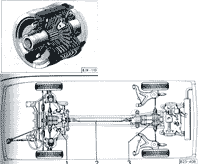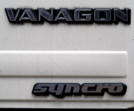differential lock and viscous coupling
back to Ludwig studio vanagon page back to vanagon photo gallery

click to enlarge & read diagram |

Volkswagen vanagon syncro 1991 differential lock
The Syncro locker was a option for the 4WD Syncro Vanagons. Most of the Syncros sold in the US have them. They consist of a crown ring that slides from side to side on a special differential body and when slid to the ring gear side it gets in the way of cogs protruding from one of the side gears and prevents it from turning, thus locking up the differential. They are activated in Vanagons by vacuum and you just pull a knob on the lower center of the dash near the gearshift to lock things up. This was an option on the early models, standard on the later ones, and really increases the capability. These fit directly into 091 boxes however there is a special hole in the Syncro boxes (093) for the cross shaft that holds a fork that slides the crown ring back and forth. Someone installed one in a 002 box in a buggy. That transmission case was machined and a special mechanism was designed to activate the locker mechanically. The 093 transmission case has the special hole. The problem with that is that a 093 case is a side shifter and won't work with a nose shift setup. Converting a buggy to work with a sideshift would be easier than converting the box to a nose shift. The Bentley Vanagon manual has some good pictures of one of these differential locks.
The above info was distilled from Vanagon.com
The following info was taken from the owner's manual:
The Differential Lock of Syncro 1991
When driving around a curve, the outside wheels turn more than the inside wheels. A rear gear set, part of the transmission, called the differential, compensates for the difference. If, however, one wheel gets on a slippery surface and starts to spin, the differential will not transmit power to the other wheel. The car will be stuck. The differential lock will allow power to be transmitted to both wheels to help get the vehicle moving again. Because the differential is then unable to compensate for cornering, vehicle handling and maneuverability will be reduced. Therefore the differential lock may only be used under limited conditions.
The differential lock for the rear axle must only be used when the vehicle is stuck or is in immediate danger of becoming stuck.
Locked differential cannot compensate for cornering and therefore increases tire wear, reduces vehicle maneuverability, driveability and can impair vehicle handling performance. To reduce the potential for loss of vehicle control, only use the rear differential lock under the specific and limited circumstances described.
Never lock the differential when driving on paved roads, or normal dry roads as it will not provide any advantage. Under these circumstances, an engaged differential lock will impair the vehicle’s maneuverability. When the differential is locked, the rigid connection between the rear wheels has a rubbing effect on the tire when cornering. This leads to increased tire wear and also to a “jerking motion” when the vehicle is being steered.
Never lock the differential when one wheel is spinning. First bring the spinning wheel to a standstill, and only then engage the differential. This prevents damage to the drive train or uncontrollable acceleration leading to loss of control and personal injury.
Never lock the differential when at excessive speed on very wet roads.
Never lock the differential when the vehicle is being towed.
Never lock the differential when testing the vehicle on a dynamometer (engine output analysis and brake test) used for performance testing. (the transaxle drive shaft must also be disconnected for this test)
Using the Differential Lock
Start from a standstill or slow way down and drive in a straight line. Engage or disengage the differential with the knob in the center of the instrument panel. When the knob is pulled (or pushed) engagement (or disengagement) is only initiated. The warning light above the knob only comes on when the lock has engaged properly. The actual locking of the differential can be delayed if the wheels are rotating at substantially different speeds. The lock will not engage (or disengage) when driving around a corner.
When the road surface has improved the lock should be disengaged.
The light goes out again once the knob has been pushed in and the lock has actually disengaged.
All-Wheel Drive Operation and the VC (viscous coupling)
In contrast to conventional all-wheel drive systems that require transmissions to be manually engaged when needed, the Vanagon Syncro all-wheel drive system is always permanently engaged. Only the amount of power being transmitted to the front and rear wheels changes automatically as the road surface demands.
As the driving force applied to the road goes to four wheels instead of two, the amount of slip is considerably reduced. This improves the traction between tire and road surface and thereby, the driveability on slippery road surfaces. On vehicles with two-wheel drive, the driving wheels can spin on slippery surfaces if too much acceleration is applied. This greatly reduces tire grip and can result in loss of vehicle control.
By distributing the driving forces to four instead of two wheels, the wheels of the Syncro are less likely to spin under the same conditions.
Driving power is greatly increased by the continual all-wheel drive especially on snow and slippery surfaces, when starting off from a standstill, and when driving on rough roads. Within reason the Vanagon Syncro can go places where other vehicles may likely get stuck. It is easier to stop on slippery hills and get going again.
The engine power is transmitted evenly to a moderately slippery road surface.
How It Works
The automatic distribution of power is accomplished through a fluid shear coupling (viscous coupling) that is part of the front axel. The design of the viscous coupling keeps driving force losses to a minimum while distributing the forward thrust to all four wheels when needed.
When the going gets rough, especially when wet, slippery or snow-covered roads cause the rear or front wheels to slip, the viscous coupling automatically transfers driving force to the other wheels to help you keep moving.
The distribution of drive forces allows the Syncro to adapt to changing road surfaces and provide increased traction automatically.
While it has the ability to handle poor weather and road conditions and has limited off-road capabilities, the Syncro is not an off-road or all-terrain vehicle.
http://syncro.org/VCTest.htmlhttp://www.vanagon.com/syncros/technical
http://www.vanagon.com/syncros/faq/syncro-faq.html
Visit the Syncro Yahoo Group on the web at:
http://groups.yahoo.com/group/Syncro/